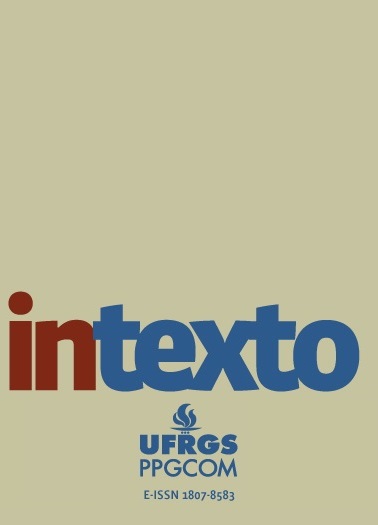From Eisenstein to Bressane: genealogies of an experimental gesture.
DOI:
https://doi.org/10.19132/1807-8583202152.104546Keywords:
Actor. Cinema. Experimental. Eye mutilation.Abstract
The art of acting occupies the center of expressive concerns that are the main pillar of researches within what is conventionally called experimental cinema. Countless filmmakers and actors used a vast palette of figurative processes to express a theme that permeates almost the entire history of experimental cinema: the act of seeing through the cinematographic device and by human vision (character / viewer). This article describes how actors and directors promoted this figurative investigation into the motif of the eye mutilation and its variables (enucleation, haemolacria, interferences and ophthalmologic surgeries) in productins outside the theoretical framework of classic cinemas.
Downloads
References
A IDADE do ouro. Direção: Luís Buñuel. Roteiro: Luís Buñuel e Salvador Dalí. 1930. (60 min.), mono, p. & b.
ALBERA, François. L’Avant-Garde au cinéma. Paris: Armand Colin, 2005.
AMOR louco. Direção: Júlio Bressane. Roteiro: Júlio Bressane. 1971. (85 min.), mono, p. & b.
AUMONT, Jacques. À quoi pensent les films. Paris: Séguier, 1996.
BORDWELL, D.; THOMPSON, K.; STAIGER, J. The classical Hollywood cinema. Film style & mode of production to 1960. London: Routledge, 2005.
BRAKHAGE, Stan. Metaphors on vision. Denver: University of Colorado: Filme Culture, 1963.
BRENEZ, Nicole. L’Ange noir – Plastiques du négatif dans le cinema expérimental. In: De la figure en général e du corps en particulier – L’invention figurative au cinema. Louvain-la- Neuve – Bégica: De Boeck, 1998.
COMOLLI, Jean-Louis. Ver e poder, a inocência perdida: cinema, televisão, ficção, documentário. Belo Horizonte: Editora UFMG, 2008.
DAMOUR, Christophe. La déploration, de Sarah Bernhardt à Al Pacino. Permanence et migration d’une posture codifiée (arts visuels, théâtre, cinéma). Cinémas Revue d'études cinématographiques, Montréal, v. 25, n. 1, p. 17-37, 2014.
DAMOUR, Christophe; VALMARY, Hélène; VIVIANI, Christian (dir.) Généalogies de l’acteur au cinéma. Echos, influences, migrations. Cycnos, Nice, vol. 27, n. 2, p. 9–18, 2011.
DUBOIS, Phillipe. Cinema, vídeo, Godard. São Paulo: Cosac & Naify, 2004.
EVEN as you and I. Direção: Roger Barlow, Harry Hay e Leroy Robbins. Roteiro: não creditado. 1937. (12 min.), mono, p. & b.
FAMÍLIA do barulho. Direção: Júlio Bressane. Roteiro: Júlio Bressane. 1970. (75 min.), mono, p. & b.
FERREIRA, Jairo. Cinema de invenção. São Paulo: Limiar, 2000.
FUNERAL parade of roses. Direção: Toshio Matsumoto. Roteiro: Toshio Matsumoto. 1969. (105 min.), mono, p. & b.
GODARD, Jean-Luc. Défense et illustration du découpage classique. Cahiers du Cinéma, Paris, n. 15, Tome III, p. 33-49, set. 1952.
KITTLER, Friedrich. Optical media: Berlin lectures 1999. Cambridge: Polity Press, 2010.
LYRA, Bernadette. A nave extraviada. São Paulo: Annablume: ECA-USP, 1995.
MAUSS, Marcel. As técnicas do corpo. In: Sociologia e antropologia. São Paulo: Cosac & Naify, 2003.
MITRY, Jean. Le cinema expérimental – histoire et perspectives. Paris: Editions Seghers, 1974.
O ENCOURAÇADO Potemkin. Direção: Serguei Eisenstein. Roteiro: Serguei Eisenstein, Nina Agadzhánova-Shutkó, Nicolai Asseiev, Sergei Tretyakov. 1925. (74 min.), mono, p. & b.
O REI do baralho. Direção: Júlio Bressane. Roteiro: Júlio Bressane. 1974. (90 min.), mono, p. & b.
REFLECTIONS on black. Direção: Stan Brakhage. Roteiro: Stan Brakhage. 1955. (12 min.), mono, p. & b.
RENAN, Sheldon. An introduction to the American Underground film. New York: E. P. Dutton, 1967.
SERMÕES: A história de Antônio Vieira. Direção: Júlio Bressane. Roteiro: Júlio Bressane. 1989. (80 min.), dolby, color e p. & b.
SITNEY, P. Adams. Visionary film – The American avant-garde. New York: Oxford University Press, 1980.
SITNEY, P. Adams (ed.) The avant-garde film – A reader of theory and criticism. New York: Anthology Film Archives, 1987. (Col. Anthology Film Archives #3).
TEIXEIRA, Francisco E. O cineasta celerado. A arte de se ver fora de si no cinema poético de Júlio Bressane. São Paulo: Annablume, 2011.
THE CAGE. Direção: Sidney Peterson. Roteiro: não creditado. 1947. (28 min.), mono, p. & b.
THE WAY to shadow Garden. Direção: Stan Brakhage. Roteiro: Stan Brakhage. 1955. (10 min.), mono, p. & b.
T,O,U,C,H,I,N,G. Direção: Paul Sharits. Roteiro: não creditado. 1968. (12 min.), mono, p. & b.
TRAITÉ de bave et d’éternité. Direção: Isidore Isou. Roteiro: não creditado. 1952. (125 min.), mono, p. & b.
TYLER, Parker. Underground Film – a critical history. Nova York: Da Capo Press, 1995.
UM CÃO Andaluz. Direção: Luis Buñuel, Salvador Dalí. Roteiro: Luis Buñuel, Salvador Dalí. 1929. (21 min.), mono, p. & b.
VELOSO, Geraldo. Por uma arqueologia do “outro” cinema. Estado de Minas, Belo Horizonte, 17 mai. 1983-14 jun. 1983.
VISUAL training. Direção: Frank Zwartjes. Roteiro: não creditado. 1969. (08 min.), mono, p. & b.
WEES, William C. Light Moving in Time: Studies in the Visual Aesthetics of Avant-Garde Film. Berkeley: University of California Press, 1992.
Downloads
Published
How to Cite
Issue
Section
License
Copyright (c) 2021 Sandro de Oliveira

This work is licensed under a Creative Commons Attribution-NonCommercial 4.0 International License.
The copyright of works published in this journal belong to the authors, and the right of first publication is conceded to the journal. Due to the journal being of open access, the articles are of free use in research, educational and non-commercial activities.
Therefore, the journal uses the License Creative Commons Attribution (CC BY-NC 4.0), which allows sharing of work with acknowledgment of authorship.
Self-archiving (repository policy): authors are allowed to deposit all versions of their work in institutional or thematic repositories without embargo. It is requested, whenever possible, that the full bibliographic reference of the version published in Intexto (including the DOI link) be added to the archived text.
Intexto does not charge any article processing fees (article processing charge).















